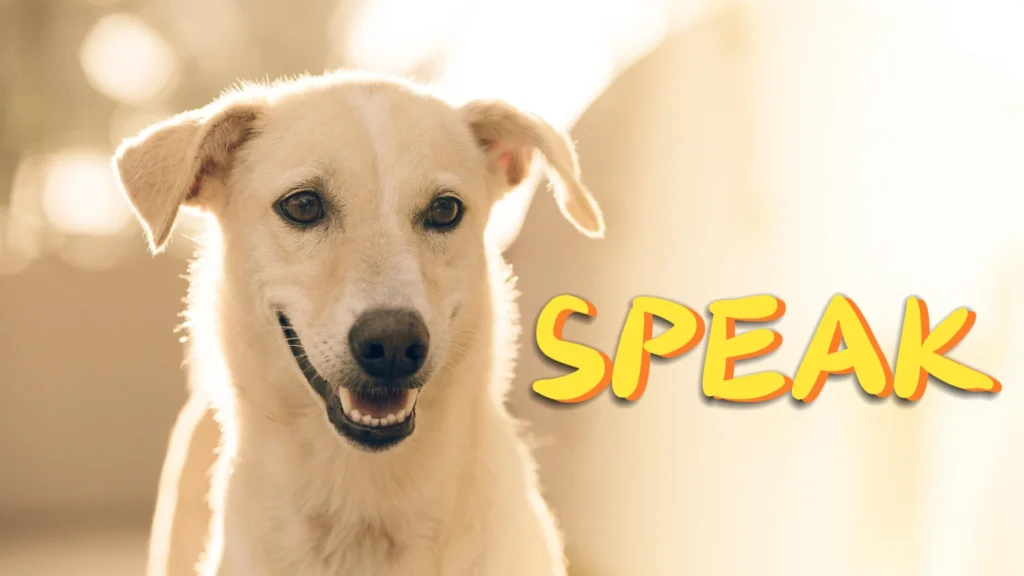The “speak” command is far more than a cute parlor trick to show off at gatherings. It’s a versatile and enriching skill. This benefits both you and your dog in multiple ways. By teaching your dog to bark on cue, you’re tapping into their natural behaviors and channeling them into something productive. Below, we’ll dive deeper into why this command is worth the effort.
Enhance Communication Between You and Your Dog
Dogs are naturally expressive creatures. They use barks, whines, and body language to convey their needs and emotions. Teaching your dog to “speak” gives them a structured way to communicate with you. This creates a clearer channel for interaction.
Random barking might leave you guessing. A trained “speak” allows your dog to vocalize intentionally when prompted. This controlled expression empowers your dog. It gives them a voice they know you’ll understand.
For example, you might eventually pair “speak” with specific situations, like barking to signal they need to go outside or want a toy. This strengthens the bond. Your dog learns they can rely on you to respond to their needs when they use the command appropriately. It’s like teaching them a word in your shared language.
Imagine coming home from work and asking your dog if they need anything—perhaps a potty break or dinner—and getting a clear response in the form of a bark. This kind of intentional communication makes life easier and helps your dog feel heard and valued.
Reduce Unwanted Barking Through Training
Excessive barking is one of the most common complaints among dog owners. Teaching “speak” can paradoxically help curb this behavior by putting barking under your control.
When barking becomes a command, it stops being an automatic reaction and starts being a deliberate action your dog performs only when asked. This shift helps them understand that barking has a time and place.
Moreover, the “speak” command naturally pairs with teaching “quiet.” Once your dog learns to bark on cue, you can introduce the “quiet” command to signal when to stop.
This combination is a powerful tool for managing noise levels. If your dog barks at passing cars, you can redirect their energy by asking for a “speak” followed by a “quiet.” Over time, they’ll learn to wait for your cue rather than barking impulsively. This leads to a calmer household and happier neighbors.
This approach transforms what could be seen as a nuisance into a well-managed behavior. Instead of scolding your dog for barking, you’re guiding them toward better habits through positive reinforcement.
Boost Confidence in Shy Dogs

Not all dogs are bold barkers. Shy dogs may hesitate to vocalize. For these pups, learning to “speak” can be a game-changer. The process of discovering and using their voice in a safe, encouraging environment builds self-assurance and helps them feel comfortable expressing themselves.
The positive reinforcement used in training shows your dog that barking on command is a good thing, not something to fear. For a timid dog, a single bark can be a big step. Celebrating that moment can boost their confidence significantly.
Over time, this newfound boldness spill over into other areas. This helps them approach new situations with less hesitation. It’s a meaningful way to help your dog grow into a self-assured companion.
Sometime you adopt dogs from shelter. Teach them the “speak” command. This can be particularly therapeutic for them. It allows them to reclaim their voice in a supportive setting. This reinforces the idea that they are safe and loved.
Provide Mental Exercise for a Healthier Dog
Dogs thrive on mental stimulation just as much as physical exercise. Without enough cognitive challenges, they become bored.
Training your dog to “speak” engages their brain. This gives them a puzzle to solve and a goal to achieve. The process of learning the cue, connecting it to the action, and earning rewards keeps their mind active and sharp.
Each training session is like a mini workout for their brain. This requires focus, memory, and problem-solving. This is especially beneficial for high-energy breeds. Even a quick 5–10-minute session can leave your dog feeling satisfied and mentally fulfilled. Plus, the sense of accomplishment from mastering a new skill boosts their overall happiness.
Mental exercise also complements physical activity. A tired dog is a happy dog. Combining mental and physical challenges ensures your pup is fully engaged and stimulated throughout the day.
Strengthen Your Bond Through Positive Interaction
Training your dog to “speak” isn’t just about the end result. It’s about the journey you take together. Every session is an opportunity to connect with your dog through play, praise, and shared goals.
Dogs love pleasing their owners. The joy they feel when they get it right deepens your relationship. Your enthusiasm and encouragement during training show your dog they’re valued and understood.
This command requires you to pay close attention to your dog’s cues and behaviors. This helps you learn more about their personality and triggers. Whether it’s discovering what excites them enough to bark or noticing how they respond to your tone, you’ll gain insights that make you a better pet parent. The result is a stronger partnership built on mutual respect and enjoyment.
Training sessions are also a great way to spend quality time with your dog. This strengthens the emotional connection between you. These moments of focused interaction remind your dog that they are your priority.
Lay the Foundation for Advanced Training
Learning to “speak” is a gateway to other tricks and commands. This is a great starting point for expanding your dog’s skill set. Once they understand how to vocalize on cue, you can build on this foundation to teach variations. It also introduces them to the concept of responding to verbal cues.
For dogs with a knack for learning, “speak” can be part of a larger repertoire. It keeps them engaged and challenged. It’s also a stepping stone to practical applications. This versatility makes “speak” a valuable addition to your dog’s training toolbox.
Advanced training opportunities also allow you to explore unique talents your dog may have. Some dogs can be trained to “sing” or mimic sounds. This adds another layer of fun and creativity to your training sessions.
Offer an Engaging Way to Show Off Their Personality
Every dog has a unique bark. Watching them perform on command is a charming way to showcase their personality. Whether your dog lets out a booming woof, a high-pitched yip, or a quirky howl, it’s a moment that highlights what makes them special.
This trick gives your dog a chance to shine in social settings. For outgoing dogs, it’s an opportunity to soak up attention and applause. For quieter dogs, it’s a low-pressure way to engage with others while staying in their comfort zone. Either way, it’s a heartwarming reminder of the joy and individuality your dog brings to your life.
Incorporating “speak” into daily routines adds an extra layer of entertainment. Imagine your dog barking “happy birthday” during festive celebrations—it’s sure to bring smiles to everyone around.
Teaching your dog to “speak” is about much more than eliciting a bark on command. It’s a multifaceted skill that lays the groundwork for advanced training. This offers endless opportunities for fun and connection. By investing time and patience in this training, you’re not only teaching your dog a new trick—you’re enriching their life and yours in countless ways.




